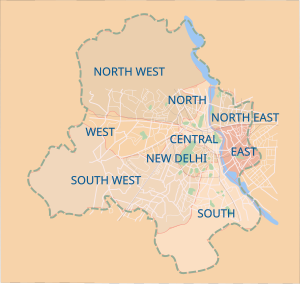
Parking Policy for Delhi(126 slides PowerPoint file, Municipal Corporation of Delhi, Dec, 2011)
Also discussed here: Congestion charges around the world - Delhi is planning to introduce a congestion charge, following in the footsteps of Singapore, London, Oslo and Stockholm (Gwyn Topham, The Guardian, Dec. 8, 2011)
Today’s review article comes from Delhi, the 100 year old Capital of India (as of today), where the need for an improved policy toward congestion and parking is proposed to relieve congestion and the amount of space used for parking of the millions of vehicles. Options considered include pricing parking spaces by location and time of day and a congestion charge for vehicles other than public entering the urban core. Many of the policies and approaches would seem to apply to other cities.

Key Quotes:
“A car is allotted 23 sq m for parking. On an average three different car spaces are needed per car in the city, result, the current fleet occupies nearly 9-10 % of Delhi’s geographic area”
“Overall Principles:
- Parking should be managed so that it supports the City’s strategic outcomes for economic development, urban development, transport, environmental, social and recreation, and cultural well being.
- Parking also has the equally important role of supporting a better land transport system for the city that is integrated, safe, responsive and sustainable
- Street space is a scarce resource and priority for use for parking needs to be considered against other uses and depends on the location, type of street, time of day and day of week
- Revenue from parking needs to reflect the parking policy and the city’s strategic direction. Pricing is an effective tool in maintaining a certain level of availability of the on-street spaces…”
“Introduction of congestion tax in select high density and business district (zones) of the city. Rationalisation of the fee in accordance with the land use and price is to be followed”
“Approaches:
- A variable pricing based on the location of the parking linked to land price is a desirable model: Parking in the centre of city will be costlier than parking in the periphery as the value of the land is different.
- Variable pricing based on hourly basis during the peak hours and lower prices during the off peak periods is recommended.
- Fee collection can be through automated methods or manual means.
- This must be carried out within the guidelines drawn up by the authority.
- Variable parking fee needs to be based on the size and type of vehicle – the larger the vehicle, the fee will be higher.
- The increase of tariff for the number of hours parked will be cumulative scale with every increase of hour parked- the fee will be higher”
Related articles
- MCD budget proposes increased property tax, congestion charges (thehindu.com)
- Delhi drivers to face congestion charge (telegraph.co.uk)
- Does Canada's Largest City Want Congestion Charges? (pollutionfree.wordpress.com)
- Why are City Politicians Nervous when Congestion Charging Comes Up? (pollutionfree.wordpress.com)
- Danish Plans for Road Pricing and Congestion Charging (pollutionfree.wordpress.com)
- Delhi plans congestion charge to ease gridlock (guardian.co.uk)
- CSE lauds MCD proposal to raise parking charges (thehindu.com)
- Congestion charges around the world (guardian.co.uk)
- Experts suggest upping parking rates, slashing free parking to de-congest Delhi (thehindu.com)
- You: Parking pain: City tops choking chart - Times of India (news.google.com)
- Traffic Accidents and Optimum Congestion Charges (pollutionfree.wordpress.com)

No comments:
Post a Comment